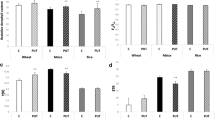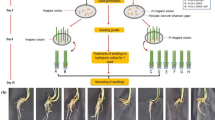Abstract
The effect of salinity and different nitrogen sources on the level of xanthine dehydrogenase (XDH) activity in roots and leaves of pea plants was investigated. Two bands of xanthine dehydrogenase activity (XDH-R2, XDH-R3) were detected in roots after native PAGE and staining with hypoxanthine as substrate. Only one band of XDH activity (XDH-L1) was detected in leaf extracts. Within leaves of three different ages the highest XDH activity was detected in young leaves both under control as well as stress conditions. Salinity did not affect significantly the activity of XDH in pea roots, however, depressed XDH activity in leaves. A significant increase of XDH activity both in roots and leaves was observed only when ammonium was applied as the sole N source. Increased concentration of ureides in the xylem sap of pea plants was observed for both ammonium and high salt treatments, although the higher content of ureides in the xylem sap of 100 mM NaCl treated plants may be rather a result of lower rate of exudation from roots than of increased root ureide biosynthesis. Thus, the changes of root and leaf XDH activity in pea plants seem to be tightly correlated with ureide synthesis that is induced by NH +4 , the product of N fixation, and rather than by salinity. A contribution of pea XDH in increased oxygen species or uric acid production under saline conditions seems to be less than likely.
Similar content being viewed by others
Abbreviations
- PAGE:
-
polyacrylamide gel electrophoresis
- XDH:
-
xanthine dehydrogenase
- XO:
-
xanthine oxidase
References
Barabás N.K., Omarov R.T., Erdei L., Lips S.H. 2000. Distribution of the Mo-enzymes aldehyde oxidase, xanthine dehydrogenase and nitrate reductase in maize (Zea mays L.) nodal roots as affected by nitrogen and salinity. Plant Sci., 155: 49–58.
Becker B.F., Reinholz N., Ozcelik T., Leipert B., Gerlach E. 1989. Uric acid as radical scavenger and antioxidant in the heart. Pflug. Arch. Eur. J. Physiol., 415: 127–135.
Bradford M.M. 1976. A rapid and sensitive method for the quantitation of microgram quantities of protein utilizing the principle of protein-dye binding. Anal. Biochem., 72: 248–254.
Cheeseman J.M. 1988. Mechanisms of salinity tolerance in plants. Plant Physiol., 87: 547–550.
Cramer M.D., Lewis O.A.M., Lips S.H. 1993. Inorganic carbon fixation and metabolism in maize roots as affected by nitrate and ammonium nutrition. Physiol. Plant., 89: 632–639.
Fridovich I. 1970. Quantitative aspects of the production of superoxide anion radical by milk xanthine oxidase. J. Biol. Chem., 245: 4053–4057.
Grattagliano I., Vendemiale G., Sabb B C., Buonamico P., Altomare E. 1996. Oxidation of circulating proteins in alcoholics: Role of acetaldehyde and xanthine oxidase. J. Hepatol., 25: 28–36.
Hoagland D.R., Arnon D.I. 1938. The water culture method for growing plants without soil. Univ. Calif. Agric. Exp. Stn., Circ., 347: 1–39.
Hernández J.A., Olmos E., Corpas F.J., Sevilla F., del Río L.A. 1995. Salt-induced oxidative stress in chloroplast of pea plants. Plant Sci., 105: 151–167.
Laemmli U.K. 1970. Cleavage of structural proteins during the assembly of the head of bacteriophage T4. Nature, 227: 680–685.
McCord J.M. 1985. Oxygen-derived free radicals in post-ischemic tissue injury. New Engl. J. Med., 312: 159–163.
Mendel R.R., Muller A. 1976. A common genetic determination of xanthine dehydrogenase and NR in N. tabacum. Biochem. Physiol. Pflanzen, 170: 538–541.
Montalbini P. 1992a. Inhibition of hypersensitive response by allopurinol applied to the host in the incompatible relationship between Phaseolus vulgaris and Uromyces phaseoli. J. Phytopathol., 134: 218–228.
Montalbini P. 1992b. Ureides and enzymes of ureide synthesis in wheat seeds and leaves and effect of allopurinol on Puccinia recondita f.sp. tritici infection. Plant Sci., 87: 225–231
Montalbini P. 1998. Purification and some properties of xanthine dehydrogenase from wheat leaves. Plant Sci., 134: 89–102.
Montalbini P. 2000. Xanthine dehydrogenase from leaves of leguminous plants: purification, characterization and properties of the enzyme. J. Plant Physiol., 156: 3–16.
Newaz M.A., Adeeb N.N.N., Muslim N., Razak T.A., Htut N.N. 1996. Uric acid, xanthine oxidase and other risk factors of hypertension in normotensive subjects. Clin. Exp. Hypertens., 18: 1035–1050.
Nguyen J. 1986. Plant xanthine dehydrogenase: its distribution, properties and function. Physiol. Vég., 24: 263–281.
Parks D.A., Granger D.N. 1983. Ischemia-induced vascular changes: Role of xanthine oxidase and hydroxyl radicals. Am. J. Physiol., 245: 285–289.
Pastori G.M., del Rio L.A. 1997. Natural senescence of pea leaves: an activated oxygen-mediated function for peroxisomes. Plant Physiol., 113: 411–418.
Peden D.B., Hohman R., Brown M.E., Mason R.T., Berkebile C., Fales H.M., Kaliner M.A. 1990. Uric acid is a major antioxidant in human nasal airway secretions. Proc. Natl. Acad. Sci. USA., 87: 7638–7642.
Radi R., Rubbo H., Thomson L., Prodanov E. 1990. Luminol chemiluminescence using xanthine and hypoxanthine as xanthine oxidase substrates. Free Radic. Biol. Med., 8: 121–126.
Rothe G.M. 1974. Aldehyde oxidase isoenzymes (EC 1.2.3.1) in potato tubers (Solanum tuberosum). Plant Cell Physiol., 15: 493–499.
Sagi M., Omarov R.T., Lips S.H. 1998. The Mo-hydroxylases xanthine dehydrogenase and aldehyde oxidase in ryegrass as affected by nitrogen and salinity. Plant Sci., 135: 125–135.
Sauer P., Frébortová J., Sebela M., Galuszka P., Jacobsen S., Pec P., Frebort I. 2002. Xanthine dehydrogenase of pea seedlings: a member of the plant molybdenym oxidoreductase family. Plant Physiol. Biochem., 40: 393–400.
Sprent J.I. 1980. Root nodule anatomy, type of export product and evolutionary origin of some Leguminosae. Plant Cell Environ., 3: 35–43.
Vogels G.D., Van Der Drift C. 1970. Differential analyses of glyoxylate derivatives. Anal. Biochem., 33: 143–157.
Teng R.-J., Ye Y.-Z., Parks D.A., Beckman J.S. 2002. Urate produced during hypoxia protects heart proteins from peroxynitrite-mediated protein nitration. Free Radic. Biol. Med., 33: 1243–1249.
Triplett E.W., Blevins D.G., Randall D.D. 1980. Allantoic acid synthesis in soybean root nodule cytosol via xanthine dehydrogenase. Plant Physiol., 65: 1203–1206.
Triplett E.W., Blevins D.G., Randall D.D. 1982. Purification and properties of soybean nodule xanthine dehydrogenase. Arch. Biochem. Biophys., 219: 39–46.
Author information
Authors and Affiliations
Corresponding author
Rights and permissions
About this article
Cite this article
Zdunek-Zastocka, E., Lips, H.S. Is xanthine dehydrogenase involved in response of pea plants (Pisum sativum L.) to salinity or ammonium treatment?. Acta Physiol Plant 25, 395–401 (2003). https://doi.org/10.1007/s11738-003-0021-4
Received:
Accepted:
Issue Date:
DOI: https://doi.org/10.1007/s11738-003-0021-4




